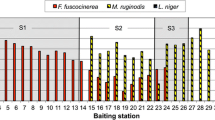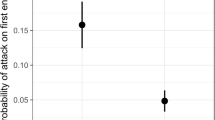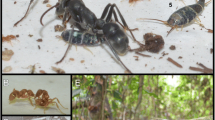Summary
Interference competition for nest sites was studied in ant communities dominated byLeptothorax congruus in the suburbs of Tokyo, central Japan. At the two study plots located in a deciduous wood and in grassland,L. congruus constructed nests in dead branches or stems of dead grasses. Approximately 50% of the nests were physically broken within a year, suggesting that they were very fragile. Of totals of 67 and 91 nests ofL. congruus marked at the two sites, 12 (17.5%) and 53 (58.2%) nests, respectively, were replaced by other ant species (Monomorium intrudens,Crematogaster brunnea teranishii,Camponotus itoi andLasius sp.) which were common in both habitats. Field observation suggested that, among these ants,M. intrudens was a major competitor usurping the nests ofL. congruus by aggressive invasion.
Similar content being viewed by others
References
Abe, T., 1971. On the food sharing among four species of ants in a sandy grassland. I: Food and foraging behavior.Jap. J. Ecol. 20:219–230.
Adamus, E. S. and F. A. Traniello, 1981. Chemical interference competition byMonomorium minimum (Hymenoptera: Formicidae).Oecologia 51:265–270.
Brian, M. V., 1952a. Interaction between ant colonies at an artificial nest-site.Ent. Mon. Mag. 88:84–88.
Brian, M. V., 1952b. The structure of a dense natural ant population.J. Anim. Ecol. 21:12–24.
Brian, M. V., 1983.Social Insects —Ecology and behavioral biology. Chapman and Hall, New York. 377 pp.
Droual, R., 1983. The organization of nest evacuation inPheidole desertorum Wheeler andP. hyatti Emery (Hymenoptera: Formicidae).Behav. Ecol. Sociobiol. 12:203–208.
Droual, R., 1984. Anti-predation behavior in the antPheidole desertorum: the importance of multiple nests.Anim. Behav. 32:1054–1058.
Herbers, J. M., 1986. Nest site limitation and facultative polygyny in the antLeptothorax longispinosus.Behav. Ecol. Sociobiol. 19:115–122.
Herbers, J. M., 1989. Community structure in north temperature ants: temporal and spatial variation.Oecologia 81:201–211.
Hölldobler, B., 1973. Chemische Strategie beim Nahrungserwerb der Diebsameise (Solenopsis fugax Latr.) und der Pharaoameise (Monomorium pharaonis L.).Oecologia 11:371–380.
Hölldobler, B., 1983a. Territorial behavior in green tree ant (Oecophylla smaragdina).Biotropica 15:241–250.
Hölldobler, B., 1983b. Chemical manipulation, enemy specification and intercolony communication in ant communities. In:Neuroethology and Behavioral Physiology (F. Huber and H. Markl, Eds.) Springer-Verlag, Berlin, Heidelberg, pp. 354–365.
Hölldobler, B. and E. O. Wilson, 1977. The number of queens: an important trait in ant evolution.Naturwissenschaften 64:8–15.
Hölldobler, B. and E. O. Wilson, 1990.The Ants. The Belknap Press of Harvard University Press, Cambridge, Mass. 732 pp.
LaMon, B. and H. Topoff, 1981. Avoiding predation by arms ants: defensive behaviors of three ant species of the genusCamponotus.Anim. Behav. 29:1070–1081.
Möglich, M., 1978. Social organization of nest emigration inLepthothorax (Hym., Form.).Ins. Soc. 25:205–225.
Ogata, K. and B. Bolton, 1989. A taxonomic note on the antMonomorium intrudens F. Smith (Hymenoptera, Formicidae).Jap. J. Ent. 57(2):459–460.
Savolanien, R., 1990. Colony success of the submissive antFormica fusuca within territories of the dominantFormica plyctena.Ecol. Ent. 15:79–85.
Smallwood, J. and D. C. Culver, 1979. Colony movements of some North American ants.J. Anim. Ecol. 48:373–382.
Smallwood, J., 1982. Nest relocations in ants.Ins. Soc. 29:138–147.
Tuji, K., 1988. Nest relocation in the Japanese queenless antPristmyrmex pungens Mayr. (Hymenoptera: Formicidae).Ins. Soc. 35:321–340.
Wilson, E. O., 1971.The Insect Societies. The Belknap Press of Harvard University Press, Cambridge, Mass. 548 pp.
Wilson, E. O., 1976. The organization of colony defense in the antPheidole dentata Mayr (Hymenoptera: Formicidae).Behav. Ecol. Sociobiol. 1:68–81.
Yamaoka, H., 1977. One example of pleometrosis colony ofMonomorium nipponense Wheeler (in Japanese with English summary).ARI 8:2–3.
Yasuno, M., 1965a. The study of ant population in the grassland Mt. Hakkôda. V: The interspecific and intraspecific relation in the formation of the ant population, with special reference to the effect of the removal ofFormica truncorum yessensis.Science Reports of the Tôhoku University Series V (Biology) 31:181–194.
Yasuno, M., 1965b. Territory of ants in the Kayano grassland at Mt. Hakkôda.Science Reports of the Tôhoku University Series IV (Biology) 31:195–206.
Author information
Authors and Affiliations
Rights and permissions
About this article
Cite this article
Yamaguchi, T. Interspecific interference for nest sites betweenLeptothorax congruus andMonomorium intrudens . Ins. Soc 39, 117–127 (1992). https://doi.org/10.1007/BF01249288
Received:
Revised:
Accepted:
Issue Date:
DOI: https://doi.org/10.1007/BF01249288




